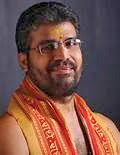Chandrasekhara Venkata Raman - A Legend of Modern Indian Science : 3.
Many people know Chandrasekhara Venkata Raman (more popularly known as C.V. Raman) because he was the first Indian Nobel Laureate in science. Till date Raman remains the only Indian to receive a Nobel Prize in science. There are two Indian-born scientists viz., Har Gobind Khorana and Subrahmanyan Chandrasekhar (who became US citizens) got Nobel Prizes in science.
Raman was also the first Asian to get Nobel Prize in science. Raman's celebrated discovery, the Raman Effect, experimentally demonstrated that the light-quanta and molecules do exchange energy which manifests itself as a change in the colour of the scattered light. However, this phenomenon was earlier predicted theoretically by Hendrik Anthony Kramers (1894-1952) and Werner Heisenberg (1901-76). It was the most convincing proof of quantum theory of light. This does not diminishes the importantce of Raman's discovery. As Albert Einstein (1879-1955) wrote : "C.V. Raman was the first to recognize and demonstrate that the energy of photon can undergo partial transformation within matter. I still recall vividly the deep impression that this discovery made on all of us…."
Raman's interests in science were wide, from astronomy and meteorology to physiology. 'Raman published 475 research papers and wrote five remarkable monographs on topics so varied that one's mind boggles'.
Raman made many major scientific discoveries in acoustics, ultrasonic, optics, magnetism and crystal physics. Raman's works on the musical drums of India was epoch-making and it revealed the acoustical knowledge of the ancient Hindus. It may be noted here that it was Pythagoras who first formulated what makes a sound musical to the human ear.
On the occasion of awarding the Hughes Medal of the Royal Society of London, Lord Rutherford (1871-1937) commented on Raman's scientific achievements as follows: "Sir Venkata Raman is one of the leading authorities in optics, in particular on the phenomenon of the scattering of light. In this connexion, about three years ago, he discovered that the light's colour could be changed by scattering. This had been predicted some time before, but inspite of search the change had not been found. The `Raman effect' must rank among the best three or four discoveries in experimental physics in the last decade; it has proved and will prove (to be) an instrument of great power in the study of the theory of solids. In addition to important contributions in many fields of knowledge, he (Raman) has developed an active school of research in physical sciences in the University of Calcutta".
To be continued ...
.jpg)




Comments